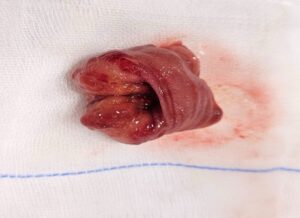Dr Jerin.K.John, Dr Mohan Abraham (Ped Surgery), Dr Aswin Prabhakaran (Ped Surgery),
Dr C. Jayakumar.
A nine-year-old boy, developmentally normal, vaccinated for age, predominantly on a mixed diet was brought with complaints of intermittent abdominal pain for the last ten days associated with multiple episodes of non-bilious, non-projectile, non-blood stained vomiting. Vitals were stable and Clinical examination was unremarkable. There was no history of constipation, blood and mucus in stool.
Differential diagnosis
– Appendicitis
– Gastroenteritis
– Constipation
– Intussusception
– Bowel obstruction
– Urinary tract infection
– Mesenteric lymphadenitis
– Inflammatory bowel disease
– Stomach ulcer
– Torsion of the testicle
– HSP
Labs done showed Tc -26 ku/ml, N- 92 %, L- 6.6 %, Hb – 12 g/dl, Platelets – 571 Ku/ml
USG abdomen was suggestive of intussusception.
The pneumatic reduction was attempted 3 times and failed so the child was taken up for lap- reduction of intussusception and Meckel’s Diverticulectomy. The post-op period was uneventful.

Histopathology report was suggestive of B lymphoblastic leukemia.
Pet scan done showed – Focal FDG avidity in MR detected STIR bright and enhancing nodule in mid ileal loops – ? residual extranodal lymphomatous deposit. No FDG avid any other lymph nodal / extranodal lymphomatous deposite.
Child was taken to another centre for further treatment.
Discussion
Intussusception is a rare condition in older children where one part of the intestine slides into an adjacent part, causing a bowel obstruction. It is the most common cause of intestinal obstruction in children younger than 3 years old, but can also occur in older children.
In older children, intussusception is more likely to be caused an underlying medical condition, such as a tumor or enlarged lymph nodes, rather than being idiopathic as in infants. Pediatric patients presenting with documented colocolic intussusception should suggest the possibility of a colonic polyp or other mass lesions.
Symptoms of intussusception in older children include sudden, intense abdominal pain, vomiting, and passing stools mixed with blood and mucus (currant jelly stool). A swollen abdomen and a lump in the belly may also be present. Intussusception requires emergency medical care, and if left untreated, it can lead to life-threatening complications like intestinal gangrene, perforation and shock.
Diagnosis is made through imaging tests like abdominal ultrasound or X-ray. Treatment often involves a procedure to push the telescoped intestine back into place using an air or barium enema. Surgery may be needed if the intestine is damaged or the enema is unsuccessful.
Atypical presentation of B-ALL
1. Extramedullary involvement
2. Bone pain, arthritis, limping
3. Hypercalcemia
4. Diffuse osteoporosis
5. Vertebral fractures
6. Intussusception
7. Absence of blasts or pancytopenia on peripheral blood smear
8. Elevated LDH
9. Elevated ESR
10. Rare CNS involvement
11. Testicular enlargement at diagnosis
Carry home message
Intussusception in older children may not always follow the typical pattern. Be vigilant for underlying causes such as lymphoma or ulcers, as prompt diagnosis and treatment are crucial for favorable outcomes.
